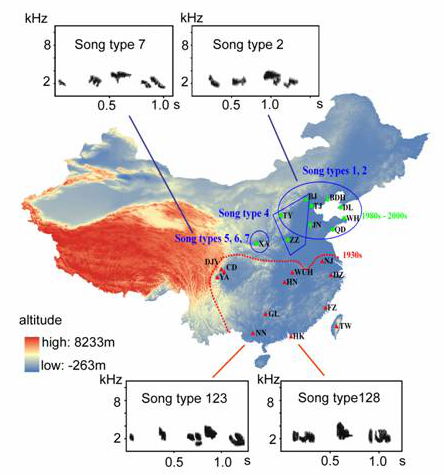Distribution range shifts due to environmental changes and geological events repeatedly occur in the evolutionary history of many species, and these shifts are increasing in frequency due to human-induced global changes. While some species have undergone range contraction, others have expanded their ranges into new areas. How an expanding population colonized successfully in the new area, and what kind of physical or behavioral changes induced responding to the new conditions? Understanding the mechanism of species establishing populations in the new environments is more attractive.
Birdsong, mainly used for territory defense and mate attraction, is a vital communicative signal in social interactions. Birdsong plays an important role in the early stage of population isolation and divergence leading to new species formation. It is therefore vital to understand how songs diverge, especially in founding populations which can not only indicate how recent climate change take effects on population differentiation but also provide historical proves for the modern population divergences. The Light-vented Bulbul (Pycnonotus sinensis), a medium-sized passerine bird previously resident south China, however has been expanding northward since 1930s, and now occupied a wide area of the north China. The ornithological research group (ORG) lead by Prof. Fumin Lei compared ~4400 songs from newly established northern populations with ~2900 songs from southern populations to evaluate song divergence after recent expansion. The total pool of syllables and especially song types was considerably smaller in the north than in the south. The ancestral pattern of mosaic song dialects changed into a pattern of wide geographical sharing of a few song types and syllables.
The reduced genetic diversity erodes the ability of a population to adapt to new environment and increase its risk of extinction. How to maintain genetic polymorphism from eroding by founder effects is also important to colonization success. The ORG analyzed population genetics of the Light-vented Bulbul and found that both high- and low-nucleotide diversities were recorded in frontier populations, and differences in genetic diversity between frontier and source populations were not statistically significant. Population differentiation was recorded in some source but not in frontier populations. Population size expansion was detected both in frontier and in source populations, commencing before the Last Glacial Maximum.
The results above imply that song evolution and vocal trait shifts can arise rapidly after range expansion, and that in the Light-vented Bulbul ‘founder effects’, geographical isolation, and recent rapid expansions played important roles in the evolution of song dialects. On the other hand, genetic diversity can be maintained in expanding populations of the Light-vented Bulbul, and genetic differentiation can be avoided, where substantial genetic exchanges are occurring. The latest rapid range expansion, beginning in recent decades, may represent a ‘new wave’ in the context of the whole population growth and expansion in response to the environmental changes since the late Pleistocene. We suspect that these properties in behavior and population genetics of the Light-vented Bulbul may affect other birds experiencing recent range expansion.
The studies were supported by the National Science Fund for Distinguished Young Scientists (No. 30925008) and NSFC Young Scientists Fund (No.31101630).
Xing XY, Alström P, Yang XJ and Lei FM. 2013. Recent northward range expansion promotes song evolution in a passerine bird, the Light-vented Bulbul. Journal of Evolutionary Biology. http://onlinelibrary.wiley.com/doi/10.1111/jeb.12101/pdf
Song G, Yu L, Gao B, Zhang R, Qu Y, Lambert DM, Li S, Zhou T and Lei FM. 2013. Gene flow maintains genetic diversity and colonization potential in recently range-expanded populations of an Oriental bird, the Light-vented Bulbul (Pycnonotus sinensis, Aves: Pycnonotidae). Diversity and Distributions. doi: 10.1111/ddi.12067 http://onlinelibrary.wiley.com/doi/10.1111/ddi.12067/pdf

Recording localities and distribution of song types in Light-vented Bulbul. Northern and southern populations indicated by green dots and red triangles respectively. Years and red dotted line indicate the distribution boundary between northern and southern populations and time of colonization. Blue figures and letters indicate the seven song types sung by northern populations. Ten northern populations were classified into 3 song dialect areas. Spectrograms show examples of different song types.

